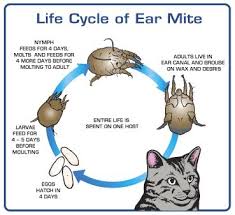Ear mites are microscopic parasites that live in the ear canals of animals. Ear mites are a common parasitic infestation in cats and dogs, causing significant discomfort and potential ear damage if left untreated. These tiny mites, most commonly Otodectes cynotis, inhabit the ear canal, leading to symptoms such as itching, inflammation, and discharge. They feed on skin debris and ear wax, causing irritation and inflammation. The most common type, Otodectes cynotis, affects both cats and dogs, but can also infest other mammals.

This guide provides a detailed overview of ear mites in pets, including their identification, effective treatment options, and prevention strategies. It aims to offer a unique and comprehensive resource for pet owners and veterinary professionals.
Life Cycle and Transmission:
Ear mites have a lifecycle that includes several stages: egg, larva, nymph, and adult. They are highly contagious, spreading through direct contact with an infected animal or contaminated environment. All life stages of the mite can be found in the ear canal, making thorough treatment essential.

Clinical Signs and Symptoms:
In Cats:
- Intense Scratching: Cats may scratch at their ears or shake their heads frequently.
- Dark Discharge: A dark, crumbly substance resembling coffee grounds may be present in the ears.
- Redness and Inflammation: The inner ear can appear red and swollen due to irritation.
- Hair Loss and Lesions: Scratching may lead to hair loss around the ears and sores from self-trauma.
In Dogs:
- Ear Scratching and Head Shaking: Similar to cats, dogs will often scratch their ears and shake their heads.
- Brownish Ear Wax: A dark, waxy discharge may be seen.
- Ear Odor: Infected ears may emit a foul smell.
- Secondary Infections: Due to scratching, dogs may develop bacterial or yeast infections in the ears.
Diagnosis:
Physical Examination and Otoscopy:
A veterinarian can diagnose ear mites by examining the ear canal with an otoscope. The mites are often visible as small, white moving specks.
Microscopic Examination:
A definitive diagnosis is made by taking a sample of ear debris and examining it under a microscope. This can confirm the presence of mites and rule out other conditions like bacterial or fungal infections.

Treatment of Ear mites:
Topical Medications:
Several topical treatments are available for ear mites, including ivermectin-based drops, pyrethrin-based products, and milbemycin oxime. These are applied directly into the ear canal to kill the mites.
Systemic Treatments:
Oral medications or injectable treatments, such as selamectin or moxidectin, can be used for more extensive infestations or when topical treatments are not sufficient.
Cleaning the Ears:
Before applying medications, it’s essential to clean the ears thoroughly. This helps remove debris and allows the medication to reach the mites more effectively.
Follow-up Care:
Rechecking the ears after a few weeks is crucial to ensure the mites are completely eradicated. Pets may need multiple treatments depending on the severity of the infestation.
Prevention Strategies:
Regular Ear Checks and Cleaning:
Routine examination and cleaning of your pet’s ears can help prevent infestations. Use a vet-approved ear cleaner and avoid over-cleaning, which can irritate the ears.
Isolating Infected Animals:
If one pet in a household is diagnosed with ear mites, it’s essential to check and possibly treat all animals to prevent the spread.
Environmental Cleaning:
Thoroughly clean the pet’s environment, including bedding and grooming tools, to eliminate any remaining mites.
Preventive Medications:
Monthly preventive medications for fleas and ticks can also help control ear mites, as some of these treatments are effective against mites.
Conclusion:
Ear mites are a common but treatable condition in cats and dogs. With proper identification, effective treatment, and preventive care, pet owners can ensure their pets remain healthy and comfortable. Regular veterinary check-ups and attention to ear health are key components in preventing and managing ear mite infestations.
- For skin diseases of dogs [CLICK HERE].
FAQs :
Q1: Can humans get ear mites from pets?
A1: While ear mites primarily affect animals, they can sometimes cause mild skin irritation in humans. However, they do not typically infest human ears.
Q2: How long does it take to treat ear mites in pets?
A2: Treatment duration varies but generally lasts 3-4 weeks. It’s important to follow the veterinarian’s instructions and complete the full course of treatment.
Q3: Are ear mites contagious to other pets?
A3: Yes, ear mites are highly contagious and can easily spread between pets in close contact.
Q4: What should I do if my pet's ear mites persist after treatment?
A4: If symptoms persist, revisit the veterinarian for further evaluation and potential additional treatment.
Q5: How can I prevent ear mite infestations in the future?
A5: Regular ear cleaning, preventive medications, and keeping the pet’s environment clean can help prevent future infestations.

